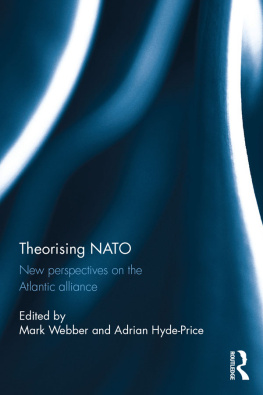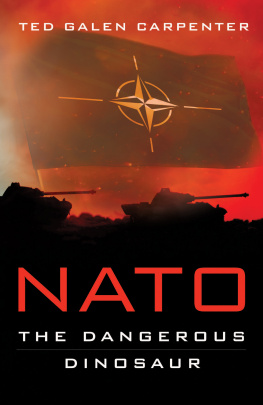
One of the keys to protecting the national security of the United States is our strong support for NATO . Since World War II, the Atlantic Alliance was established to make clear to Russia and any adversary that the U.S. will stand with our allies to defend our national security. There can be no ifs, ands, or buts to our commitment to NATO .
Leon E. Panetta, former secretary of defense
NATO is the most important institution uniting the West, and today the alliance is threatened by nationalism and a growing inability to distinguish fact from fiction. Through contributions by diplomats, military leaders, and scholars, this important work focuses on NATO s current operations and future threats, showing the alliances continued importance in the twenty- first century.
Gen. Michael V. Hayden, U.S. Air Force (Ret.), former director of the Central Intelligence Agency and the National Security Agency
Drawing on their own scholarly backgrounds as well as expert academic and practitioner analysis, Slobodchikoff, Davis, and Stewart offer perspective on NATO today as well as chart its future course. Acknowledging that NATO remains the predominant institution binding the Atlantic community, the authors buttress their argument that despite severe challenges, NATO is no less important today than it was seven decades ago.
Brig. Gen. John Adams, U.S. Army (Ret.), former deputy U.S. military representative of the NATO Military Committee
This volume creatively combines the talents and experience of American and European former senior officials, operational officers, and academics to survey NATO s past, present, and future. The mix of perspectives offers important insights into contemporary transatlantic security issues that should be of interest to international affairs scholars and students as well as practitioners.
Stanley R. Sloan, author of Defense of the West: Transatlantic Security from Truman to Trump
This timely volume is an important contribution toward a better understanding of the core alliance of our postWorld War II civilization. Superbly edited, its wide range of authors weave a compelling justification for just how important this thirty-nation treaty is for the stability for the transatlantic, and greater world.... It has a highly relevant focus on future opportunities, and challenges, including a dynamically changing regional and global security environment, and fast-mutating, disruptive hybrid activities and cyber-enabled technologies.
Brig. Gen. Peter Zwack, U.S. Army (Ret.), Wilson Center Global Fellow at the Kennan Institute
A timely and useful analysis of the main issues confronting the alliance as it develops and adapts to an ever-evolving security environment. Benefiting from the input of many distinguished scholars and practitioners in the field of international security, this volume brings a valuable contribution to the process of in-depth strategic reflection that underpins NATO s endeavors to chart its course as the most powerful and successful military alliance of the twenty-first century.
Nicolae-Ionel Ciuc, minister of National Defense of Romania
The Challenge to NATO
Global Security and the Atlantic Alliance
Edited by Michael O. Slobodchikoff, G. Doug Davis, and Brandon Stewart
Foreword by John W. Schmidt
Potomac Books
An imprint of the University of Nebraska Press
2021 by Michael O. Slobodchikoff, G. Doug Davis, and Brandon Stewart
Cover designed by University of Nebraska Press; cover image iStockphoto / Belyay.
All rights reserved. Potomac Books is an imprint of the University of Nebraska Press.
Library of Congress Control Number: 2021009785
The publisher does not have any control over and does not assume any responsibility for author or third-party websites or their content.
Contents
John W. Schmidt
Michael O. Slobodchikoff, G. Doug Davis, and Brandon Stewart
Robert E. Hunter
Jeff J. Mrazik
Mary N. Hampton
Richard Ledet, Sharon Emeigh, and Pete A. Turner
Chris Rein
Boris Havel
Wesley Clark
Tad A. Schnaufer II
Jnis Karlsbergs
Brandon Stewart
Michael O. Slobodchikoff and G. Doug Davis
Robert G. Bell
George-Cristian Maior
G. Doug Davis, Brandon Stewart, and Michael O. Slobodchikoff
The Significance of NATO s Seventieth Anniversary
John W. Schmidt
I begin by posing a very simple but important question: Would we or could we form a NATO alliance today, if one did not exist?
This question provokes examination of how NATO was created seventy years ago and its relevance through the years. One finds visionary leaders shaping an alliance of shared vital interests. On a military-to-military basis, the alliance has more than proven its value. In the world of 2019, forming such an organization like NATO would require key elements and at its core relevancy.
The end of World War II saw the emergence of the atomic age. Even though Nazi Germany had been vanquished, European security remained a vital interest to the United States. While the Soviet Union had been an Allied power in the conflict, it quickly emerged as the major rival to the United States. In this period of significant change in global politics, visionary leaders such as President Harry Truman and Secretary of State Dean Acheson in the United States, as well as German chancellor Konrad Adenauer and UK prime minister Clement Attlee saw a need for common defense.
The United States was recognized as a world leader, and other nations were reliant on her leadership. In 1947 the Truman Doctrine stated that the U.S. would lead politically, militarily and economically in assisting all democratic nations threatened by authoritarian regimes. This set the stage for engagement and involvement in world affairs.
On the European front, a spirit of reconciliation, rebuilding, and renewed trust emerges in the aftermath of World War II. Clement Attlee becomes a key architect of NATO , and Adenauer begins bridge-building associations with France and the United States. During this time the United States and Europe begin to face the common threat of communism and an aggressive Joseph Stalin centered on bringing Eastern Europe under Soviet Union influence doctrinally, militarily, and economically. Given the threat that communism posed to both the United States and Europe, it is easy to see why a mutual defense treaty such as NATO would emerge. Each nation viewed its vital interests stronger together than apart.
On April 4, 1949, the North Atlantic Treaty Organization is formed and the alliance is signed by the United States, Canada, France, the United Kingdom, Belgium, Norway, Denmark, Netherlands, Iceland, Luxembourg, Italy, and Portugal. NATO s main purpose was to provide for common defense against the Soviet Union. Article 5, one of the most important facets of the treaty, President Truman called a shield against aggression. Known as the common defense and security clause, it defines an attack on any member nation as an attack on all. Today, thirty nations are signatories, to include Greece, Turkey, Germany, and most recently North Macedonia.
Some seventy years later, NATO has been tried and tested, yet the treaty remains viable and intact. From member nations standing aloof during the conflict in Vietnam, due to the fact that this conflict was outside the scope of the treaty, to possible Soviet attacks on the northern flank of NATO in the 1980s, NATO has endured. During the first Gulf War, overflight rights and basing rights in Turkey, Germany, and Italy, among other nations, were essential in bringing a half-million troops and related heavy equipment into Saudi Arabia to oust Iraqi forces from Kuwait. In the Bosnian War, staging areas in Europe for U.S. aircraft were essential in conducting numerous air campaigns that helped bring about an end to the conflict. Today, routine Mediterranean deployments and exercises with NATO troops and training opportunities in NATO host countries sharpen interoperability. At the military level, the NATO alliance remains strong and vital to U.S. security and security of member nations.
Next page











